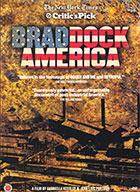
Braddock America 2013
Distributed by First Run Features, 630 Ninth Avenue, Suite 1213, New York, NY 10036; 212-243-0600
Produced by Fabrice Coat
Directed by Jean-Loïc Portron and Gabriella Kessler
DVD, color, 100 min.
Middle School - General Adult
Rust Belt, Urban Blight, Sociology, Steel Industry and Trade, Economic History
Date Entered: 01/20/2016
Reviewed by Christopher Lewis, American University Library, American UniversityBraddock, Pennsylvania is a mill town east of Pittsburgh that has suffered the same fate as many Rust Belt towns, where the jobs went overseas decades ago. What was once a thriving community is now nearly a ghost town, with factories standing empty awaiting demolition and scores of abandoned houses blighting neighborhoods. What remains of the population is a collection of lost souls filled with depression, bitterness, bewilderment, and wistfulness for the past. Braddock was one of America's first and most productive steel towns. It’s where Andrew Carnegie set up his first mill, the Edgar Thomson Steel Works, and incidentally his first public library. The mill provided steel for the railroads and bridges needed for the rapid settlement of the country as well as for the manufacture of ships and tanks during World War II. Unfortunately, with globalization and the availability of cheap overseas labor, the mill’s production was drastically reduced, the town was all but abandoned, and the remaining residents were left to pick up the pieces. Today the population is a fraction of what it was in the boom times and the town is poverty stricken.
The documentary by French filmmakers Portron and Kessler is structured as a mosaic composed of disjointed settings and personalities coalescing to form a more complete picture, in a style similar to the work of documentarian Charles Guggenheim. The viewer hears from individuals in many walks of life including retired old-timers, a local policeman who spends much of his time cataloging abandoned houses, members of the City Council, and others who didn't have the inclination or wherewithal to get out. There are few children seen in this community that continues to struggle to make a go of it. Despite the situation, it is clear that Braddock has a sense of community that endures.
There is no narrative arc and no informative titles but the pastiche of personalities and sights of what remains leave a powerful impression. The story of Braddock steel has been the subject of other films, such as Struggles in Steel (1996), and the mayor, John Fetterman, has garnered national media coverage for his efforts to revive the community’s economy. But this film is much more impressionistic, with a rawness and quirkiness that will touch many viewers more than a straightforward historical treatment of the subject would. At 100 minutes, this style of documentary is unlikely to receive much classroom use but should be considered a strong optional selection for general collections and of greater interest for anthropology, sociology, American studies, and libraries in the Rust Belt region.